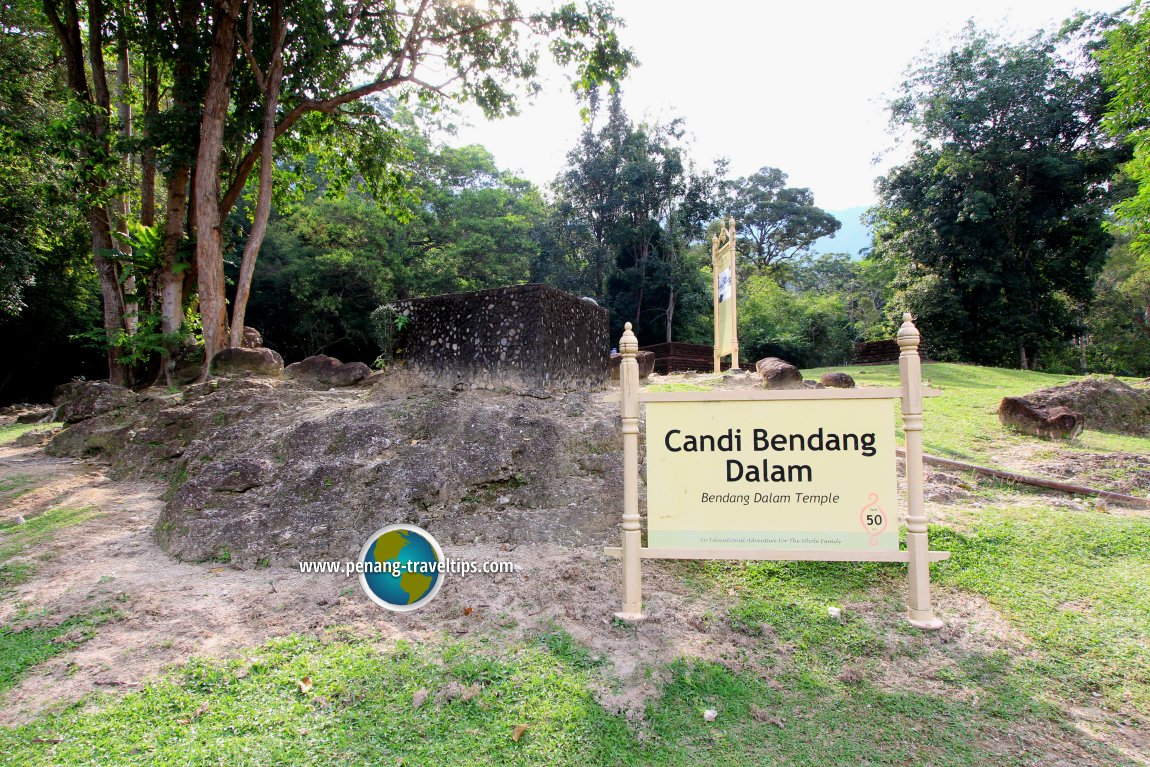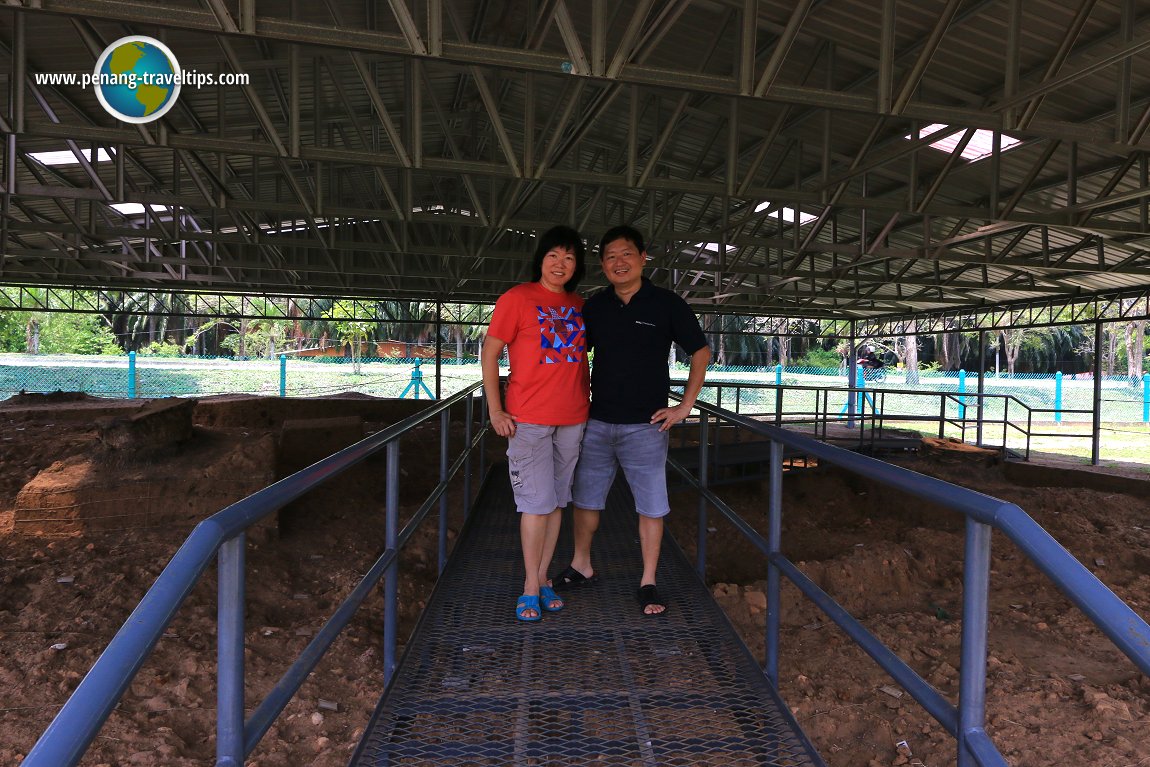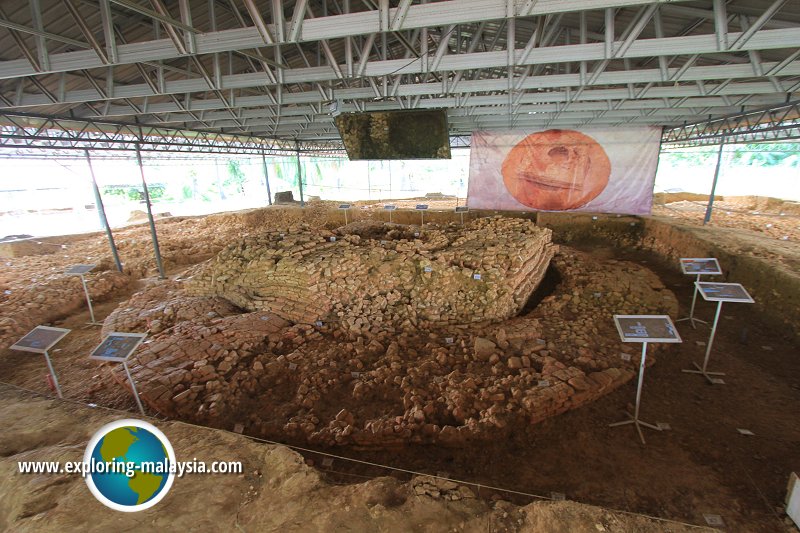 Discover Bujang Valley Archaeological Sites (23 April 2017)
Discover Bujang Valley Archaeological Sites (23 April 2017)
B. Melayu
Bujang Valley, or Lembah Bujang, is the largest archaeological site in Malaysia. Geographically, the name Bujang Valley refers to the area drained by Sungai Bujang, a tributary of Sungai Merbok. However, based on ancient monuments discovered, the Bujang Valley Archaeological Site is determined to cover a larger area, encompassing places as far as Kota Sarang Semut in the north, Bukit Mertajam in the south and Jeniang to the east, with Gunung Jerai located at the centre.
Etymology of the name Bujang Valley
The name "Bujang" has nothing to do with the meaning in modern Malay. According to historian Dato V. Nadarajan, it is derived from the Sanskrit word bhujagga, which means "serpent" or "wisdom". I checked in my Sanskrit dictionary, and found भुजङ्ग (serpent); I did not find anything similar for "wisdom". Dato Nadarajan hypothesized that the name was used to describe the meandering Sungai Bujang (or perhaps Sungai Merbok).Archaeological excavations at Bujang Valley have been carried out on and off since the 19th century. It was initially by amateur historians and enthusiasts beginning with British Lieutenant Colonel James Low, who in 1845 discovered evidence pointing to the existence of an ancient civilization in the Bujang Valley. Since then, various people have escavated at Bujang Valley. Some of the early ones were not trained archaeologists but amateurs who were keen in learning about ancient civilizations, while the later ones were researchers and experts from universities. They include the Waleses (1936-40), Alastair Lamb (1958-60), Adi (1983), Nik Hassan (1984), Allen (1988) and Mokhtar Saidin (2012-present).
Much of what we know of the ancient sites at Bujang Valley can be attributed to the work carried out by a team of husband-and-wife amateur archaeologists, H.G. Quaritch Wales and his wife Dorothy Wales. They carried out excavations in the Bujang Valley in 1936-38, and in 1936 discovered Candi Bukit Batu Pahat, today the most celebrated of the Bujang Valley monuments.
 The grounds of the Bujang Valley Archaeological Park (25 July, 2015)
The grounds of the Bujang Valley Archaeological Park (25 July, 2015)
It was also the Waleses who introduced the number system for the sites at Bujang Valley. The system, still in use today, follows a sequence according to when the site was discovered. In addition, the monuments are named after the geographic location, for example, the first site that was discovered by James Low in 1845 was given the numbering Site 1 by the Waleses, and named Candi Bukit Choras, after the area near Kota Sarang Semut.
The more we know about Bujang Valley, the more astounding the site has become. Initially, archaeologists had thought that the Bujang Valley civilization began in the 9th century. With more sites excavated and the samples analyzed, the dates have since been revised to the 1st century AD. This makes Bujang Valley the first ancient civilization in Southeast Asia, long preceding Borobudur and Angkor.
Bujang Valley is the oldest entrepôt in Malaysia, preceeding the port of Malacca. Bujang Valley developed between the 4th and 14th century, when traders from many countries, but primarily Indians, settled here, bringing with them their culture and religion. Sungai Bujang, Sungai Muda and Sungai Merbok, as well as Gunung Jerai (Kedah Peak) all played significant role in the growth of commerce in Bujang Valley. Gunung Jerai was used by the early traders to guide them to Bujang Valley.
Early Malays were already active traders, making long-distance voyages across the Bay of Bengal. They traded forest products for metal, textiles and other rarities. The influx of Indian traders into Bujang Valley led to the "Indianization" of the valley. Archaeological evidence pointed now to the establishment of an ancient Hindu-Buddist kingdom in Bujang Valley from as early as the 1st century AD. Items discovered include inscribed stone caskets, stelae, metal tools and Hindu figurines.
The discovery of Chinese porcelain, stone carvings and Indian tridents in Bujang Valley attest to the trade that flourished here many centuries ago. Buddhist inscriptions found in the valley showed that there is more than one faith represented here. Bujang Valley was a safe harbour for traders from the faraway places who had to wait out the change in monsoon, as it was not possible to make a voyage from China to India within one season.
Thousands of artefacts have been discovered here, of which some 1000 pieces are on display at the Bujang Valley Archaeological Museum. The first temple ruin in Bujang Valley was discovered in the 1840's. It is called a candi, pronounced "chan-dee", a name that came from "changriga", which is derived from "durga", and evolved from Paravati, the name of the wife of the Hindu deity Shiva (also written Siva).
The candi has two funtions: as a sacred place to pay respect for deceased members of the royal family, and as a place to conduct religious activities.
The candi consists of three main sections:
The candis in Bujang Valley were Buddhist as well as Hindu structures. The Hindu candi consists of the vimana, or enclosed sanctuary, where the main icon was kept; and the mandapa, or open sided hall, with a roof supported by pillars. The majority of the candi in Bujang Valley bear Hindu influences while a small number Buddhist. The discovery of stone pillar bases points to South Indian influences in the design of the candi, especially for temples dedicated to Shiva.
 Sungai Merbok Kechil waterfall. This was where the rocks were obtained to build Candi Bukit Batu Pahat. (25 July, 2015)
Sungai Merbok Kechil waterfall. This was where the rocks were obtained to build Candi Bukit Batu Pahat. (25 July, 2015)
Hindu icons discovered in Bujang Valley included Ganesh (also written as Ganesha), the elephant-face deity, and Durga, wife of the deity Shiva. 4 terracotta Buddhist images and one of bronze were also discovered in Bujang Valley in 1976.
Different researchers have proposed different teories with regards the Indian elements at Bujang Valley.
H.G. Quaritch Wales split the discoveries into four different waves of Indian migration, namely Amarvathi Theravada Buddhism around the 3rd century AD, Gupta Theravada Buddhism from the 4th to the 6th century AD, Pallava Saivism from the 6th to the 8th century AD and Pala Mahayana Buddhism from the mid 8th century AD onwards.
 Model of Candi Bukit Batu Pahat at the Bujang Valley Archaeological Museum (25 July, 2015)
Model of Candi Bukit Batu Pahat at the Bujang Valley Archaeological Museum (25 July, 2015)
Alistair Lamb also split the development at Bujang Valley into four different phases, but follows a different approach. What is between the 4th and 6th century is deemed the Early Buddhist phase. Following that is the Sri Vijayan phase, from the 7th to the 10th century, then the Pengkalan Bujang phase from the 11th to the 13th century, and finally the Kuala Muda phase, from the 14th century.
Nik Hassan Shuhaimi separates the finds into two broad categories: the Sungai Mas phase from the 3rd to the 10th century, which he calls the Buddhism phase, and the Sungai Bujang phase, from the 11th to the 14th century AD, which he calls the Saivism phase.
Dato' Nadarajan also forms his own theory based on observation of the development of trade, political and religious influences. He splits the development into three phases. The first, from the 1st to the 4th century, the second from the 5th to the 9th century, and the third, from the 10th to the 13th century.
 Bujang Valley artefact in the form of a stupa with Buddha images at cardinal directions (25 July, 2015)
Bujang Valley artefact in the form of a stupa with Buddha images at cardinal directions (25 July, 2015)
For most Malaysians, our introduction to Bujang Valley came from a fleeting chapter in our history book. There is not much that we knew, and indeed, when our history book was written, not much was know about Bujang Valley archaeological site. What information is known about the site is usually behind the walls of the universities. Like so many, I have also been intrigued by ancient civilizations. I have visited Borobudur, Angkor and many other ancient sites, and have learned so much about them. But there was no one to help unlock the secrets of Bujang Valley for me. It was only in 2011 that a book was written targeting the general public, and this has ignited a resurgence of interest in Bujang Valley.
 Michael Rawlinson discussing with Dato V. Nadarajan on the Bujang Valley civilization (11 August, 2015)
Michael Rawlinson discussing with Dato V. Nadarajan on the Bujang Valley civilization (11 August, 2015)
The book "Bujang Valley, The Wonder that was Ancient Kedah" was written by someone who grew up in the area, who like many of us, first got to know of the Bujang Valley from the history book, and who as a young boy had cycled to the sites to survey them. His name is Dato' V. Nadarajan. He is a retired lawyer and erstwhile history teacher. He now stands at the forefront in telling people about Bujang Valley and reviving interest in the ancient site.
I have the privilege of meeting Dato' Nadarajan on 11 August, 2015. With my friend Michael Rawlinson, I sat down with Dato' nadarajan and heard first hand from him about Bujang Valley. After our meeting, Dato' Nadarajan even took us to the Sungai Batu Archaeological Site, where the latest Bujang Valley excavations were being carried out.
Even as I conclude this article (July, 2015; updated June 2017), our knowledge of the ancient civilisation that once existed at Bujang Valley is not complete. We can expect to know more, as fresh discoveries are made in the future.
Map of Bujang Valley Archaeological Sites
Cherok Tokun Relics 
This is the southernmost of the Bujang Valley relics discovered so far.
 Bujang Valley, Kedah (25 July, 2015)
Bujang Valley, Kedah (25 July, 2015)
 The reconstructed Candi Bendang Dalam at the Bujang Valley Archaeological Park (17 July, 2015)
The reconstructed Candi Bendang Dalam at the Bujang Valley Archaeological Park (17 July, 2015)
 Bujang valley artefacts (25 July, 2015)
Bujang valley artefacts (25 July, 2015)
 Here I am with Dato V. Nadarajan and my fellow history enthusiast, Michael Rawlinson. (25 July, 2015)
Here I am with Dato V. Nadarajan and my fellow history enthusiast, Michael Rawlinson. (25 July, 2015)
 My wife and I at Sungai Batu Archaeological Site, the largest excavation in Bujang Valley. (23 April, 2016)
My wife and I at Sungai Batu Archaeological Site, the largest excavation in Bujang Valley. (23 April, 2016)
Back to Discover Kedah
 Latest updates on Penang Travel Tips
Latest updates on Penang Travel Tips

Copyright © 2003-2025 Timothy Tye. All Rights Reserved.

 Go Back
Go Back

















